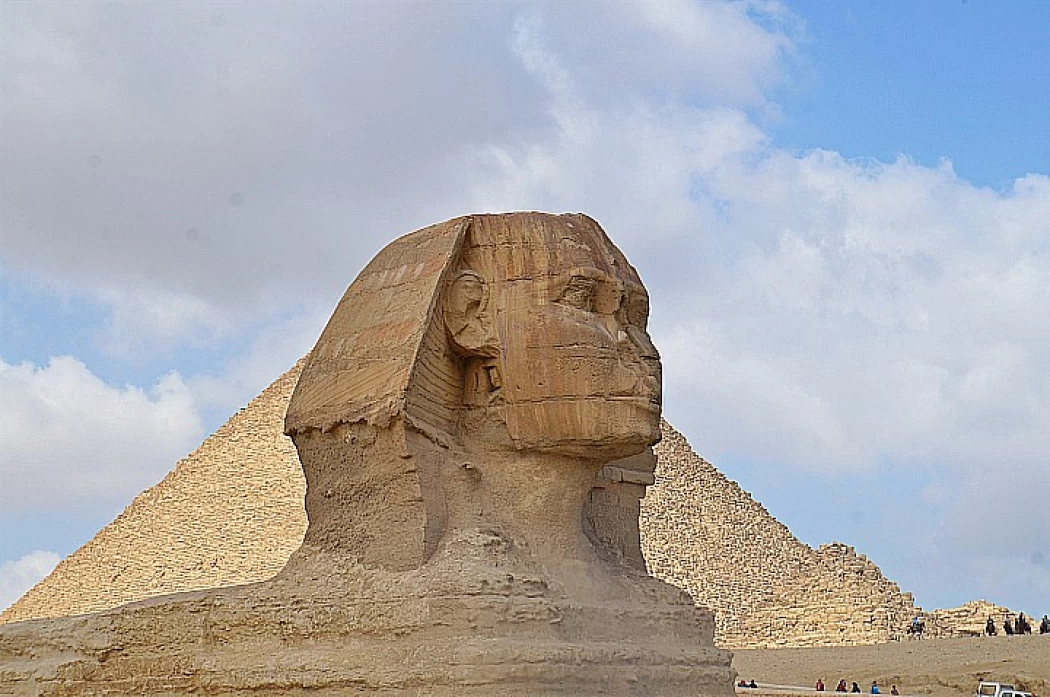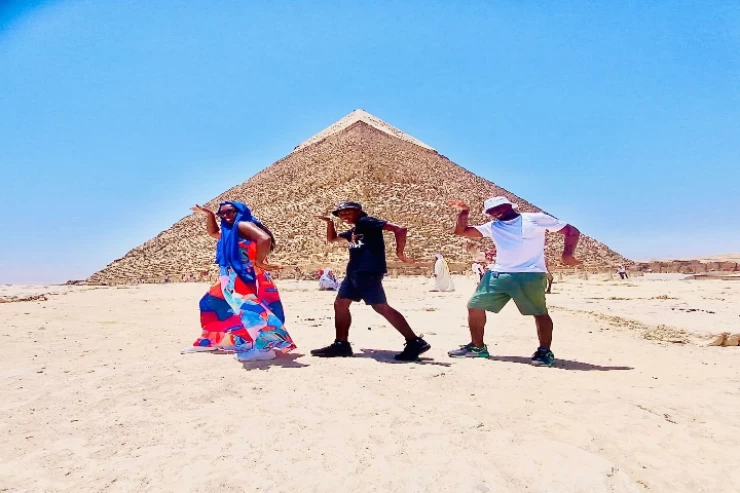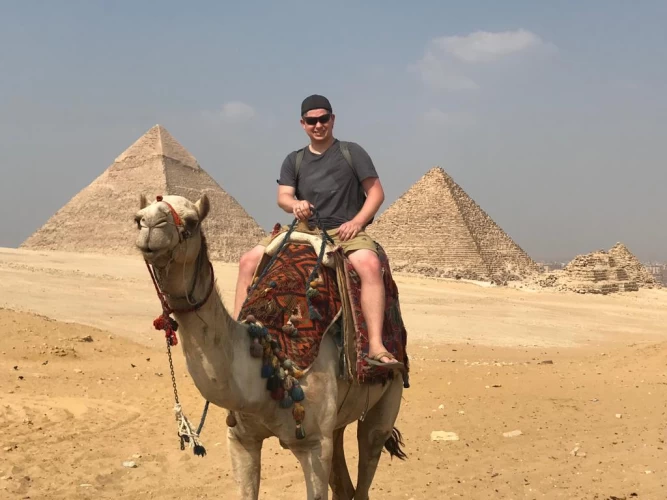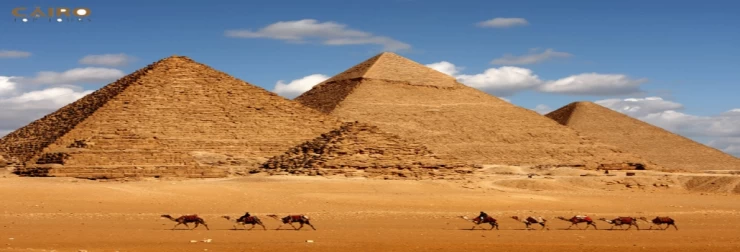
La Grande Sfinge di Giza
Fatti riguardanti la Sfinge
La sfinge, un misto di corpo animale e testa umana, era considerata un guardiano spirituale nell'antico Egitto, tipicamente raffigurato come un maschio con un copricapo faraonico simile a quello della Grande Sfinge. Rappresentazioni di questi esseri erano presenti nei luoghi di sepoltura e nelle strutture religiose, come il viale delle sfingi che collega i templi di Karnak e Luxor. Durante i tour di un giorno in Egitto, scoprirete che la Sfinge ha un passaggio sotto l'orecchio che la collega alla Grande Piramide di Khufu.
Hatshepsut, il faraone donna, è legata alle sfingi, come la statua di granito del Metropolitan Museum of Art di New York e la grande sfinge di alabastro del tempio di Ramessid a Memphis, in Egitto.
Il volto è privo del naso largo un metro. Un esame del volto della Sfinge mostra che il naso è stato rimosso inserendovi lunghe aste o strumenti, uno sotto il ponte e l'altro sotto la narice, e poi tirandolo verso sud. Mark Lehner, che ha condotto un'indagine archeologica, ha stabilito che è stato deliberatamente danneggiato con degli strumenti tra il III e il X secolo.
Circa 2.000 anni dopo la costruzione della statua, il termine sfinge ha avuto origine nella mitologia greca come enigma legato alla Grande Sfinge in Egitto durante il suo massimo splendore.
Durante i vostri tour classici in Egitto, conoscerete anche una lastra di granito rosa situata tra le zampe della Grande Sfinge, che racconta la storia del principe Thutmose, figlio di Amenhotep II. Mentre si appisolava accanto alla Sfinge, ebbe la visione che questa gli avrebbe conferito il titolo di Faraone in cambio di un aiuto per rimuovere la sabbia che la ricopriva.
Il capitano Giovanni Battista Caviglia, un esploratore, tentò nell'Ottocento di scavare la statua insieme a 160 uomini perché la Sfinge era coperta di sabbia fino alle spalle. Solo alla fine degli anni '30 Selim Hassan, un archeologo egiziano, riuscì a liberare la creatura dalla sua sepoltura di sabbia.
Durante il primo periodo dinastico, si riteneva che la Sfinge fosse il centro del culto del sole, finché nell'Antico Regno l'altopiano di Giza si trasformò in una necropoli, che assomigliava alla Sfinge. Il Causeway, il tempio mortuario di Chefren e il tempio della Sfinge sono tutti componenti di un complesso che esisteva prima della IV dinastia.
Undeniably among the most mysterious yet recognizable structures across the globe is the Great Sphinx of Giza. The Sphinx is located on the Giza Plateau near Cairo, from where it is also accessed. This sphinx is a huge statue sculptured from limestone and takes on the form of a lion with a human head believed to be that of Pharao Khafre. This captivating structure has been a topic of interest for many historians and archaeologists, including tourists, for many years, as its structure is enveloped with mystery and ancient wisdom.
The Genesis and Building of the Great Sphinx
The Great Sphinx was constructed by Pharaoh Khafre around 2500 B.C., making it one of the oldest monumental edifices in Egypt. It is formed from a single mass of limestone bedrock protruding from the Giza Plateau and carved intricately out of it. Twenty meters (66 feet) tall and 73 meters (240 feet) long, the Sphinx was probably built as a symbolic sentry to the nearby pyramids in which the pharaoh was entombed.
The structure and location of the Sphinx remain controversial, as some believe it is a standalone monument, and many other wannabe temples and causeways leading to the Pyramid of Khafre existed. Further explanation to support this theory suggests that the construction of the Sphinx took the toil of a great number of laborers armed only with copper chisels that were very crude. While it may be corniced and age-worn, this edifice stands proud as an accomplishment of the ancients.
Decoding the Sphinx: Symbolism and Significance
The Sphinx is mainly considered representative of the two vital qualities of the pharaoh, i.e., his intelligence and strength, by combining the man and a lion figure. The sphinx head bearing the same royal headdress as the pharaoh in question probably represents the more realistic likeness of the pharaoh Khafre, whose power and divine connection we'll see through this image. According to some Egyptian mythological accounts, lions served as protectors, particularly over sacred areas; in this sense, the lion body of the sphinx reiterates its function of guarding the king's burial ground.
The Sphinx in particular has changed over the years in the way that it typifies things. Some researchers believe that it could depict the sun god Ra, who held a fundamental position in the hierarchy of Egyptian beliefs and ideologies. The Sphinx has a direct pose towards the east, which happens to be the direction of the sunrise, which could add some credence to this assumption since Ra was depicted as the god who rode across the sky in a boat each day.
The Great Pyramid has its enigma
A century of theories and the Sphinx is still an enigma. One of the most conventional inquiries is: who constructed the Sphinx for what purpose? Almost all historians agree that it was built by Pharaoh Khafre. Some other theories, on the contrary, argue that the Sphinx was constructed in very remote times, perhaps even before the pyramids.
Also, some myths and beliefs about secret rooms or caves under the Sphinx remain largely unexamined. Many think that these lost spaces, if any, may house ancient scrolls or other historical items that may help in understanding some forgotten histories of Egypt. Lately, breakthroughs in ground-penetrating radar and similar technologies have tried addressing these, but so far nothing conclusive has been found.
Yet another unsolved puzzle relates to the Sphinx’s nose, which has not been seen for ages. Many speculations have been offered on its fate, including one that says it was blown off by the cannon of Napoleon’s soldiers and another that claims the Mamluks simply used it as a practice dummy. Yet there are existing records and drawings from before the era of Napoleon, which clearly show the Sphinx from the front and without the nose, suggesting that the damage had likely taken place far before that.
The Sphinx and modern restoration efforts
Through the ages, the Great Pyramid has been eroded, vandalized, and polluted, which has brought about many campaigns aimed at restoration. The Sphinx was first recorded to be attempted to be restored by Pharaoh Thutmose IV, where it was noted that he dreamt of the Sphinx informing him that he would be the king if he got rid of the sand that had covered its lower portions. Thutmose IV later erected a slab known as the Dream Stele to document this incident, which was placed in between the Sphinx’s feet.
In recent years, measures to protect the structure have involved both containment of its damage in terms of its erosion and adding extra support to the stone structure. However, in recent years, the projects have shifted focus to addressing the degradation caused by water penetration and pollution from the city of Cairo. Such measures are still active as conservationists and archaeologists try to find better ways of ensuring this ancient wonder's protection for the coming civilization.
The Great Sphinx’s visitation is something that is difficult to put into words. It can be found next to the Giza Pyramids, which makes logistics simple, and it is also common in tours around the historical sites in Cairo. As they stand next to the Sphinx, one can hardly escape the large scale of the ancient sculpture that exists in detail. The scenery outside the Sphinx also offers captivating views of the pyramids, making it a perfect place for people interested in capturing the moments in history with a camera.
The Sphinx, as one of the world’s most recognizable structures, records millions of visitors every year who can’t wait to look at its calm and enigmatic face. From dawn till dusk, the Sphinx exerts itself over the Giza Plateau, a sculpture chronicling the civilization of ancient Egypt.
The Great Sphinx in Popular Culture
Popular culture has made the sphinx an icon. Literature, film, and art have all featured the sphinx. Many works have been influenced and inspired by them, starting from ancient Greek poetry and ending in films today. Various cultures have also embraced the Sphinx Monster, who protects and asks challenging questions.
Therefore, fitting within the categories of significance and importance, the Great Sphinx of Giza has remained a fascinating emblem associated with the history of Egypt. There continue to be various explanations offered regarding its construction, significance, and symbolism. The Sphinx is forever a sentinel of the sands, a remnant of the long-gone age whose civilization thrived along the banks of the Nile River. Going to the Sphinx is not simply going to see an ancient site; it is going to confront the most mysterious and inexplicable issues that have beset mankind since time immemorial.Decoding the Sphinx:


















